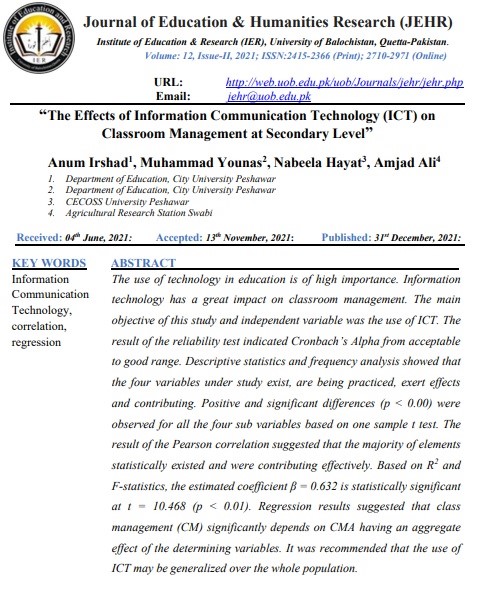The Effects of Information Communication Technology (ICT) on Classroom Management at Secondary Level
Keywords:
Information Communication Technology, correlation, regressionAbstract
The main objective of this study was to explore the effect of ICT use on Classroom management. The main independent variable of the study was the use of IT. While the sub independent variables included class room management (CM), Management of Teaching (MOT), Behavioral Management (BM), and Time Management (TM). The target population of the study was all the teachers of public and private, both girls and boys secondary school in district Swabi. A sample of 240 teachers was purposively selected having a truly representative character. A pilot study was conducted to determine the reliability and consistency of the research instrument. The result of the reliability test indicated Cronbach’s Alpha from acceptable to good range. Descriptive statistics indicated the demographic constitution of the sample. One sample t-test, Pearson Correlation Analysis, and Regression were applied for the data analysis. The major findings of the study indicated that elements of all four variables appeared to be having the mean and standard deviation values in a reasonably acceptable range. The result of the Pearson correlation suggested that the majority of elements statistically existed and were contributing effectively. Regression results of Class Management (CM) statistically significantly dependent on the aggregate determining variable CMA, having an aggregate effect of the determining variables MOT, BM and TM. It was recommended that the use of ICT in Management of teaching (MOT), Behavioral management (BM), and Time management (TM); may be generalized over the whole population.
References
Anandan, K., & Gopal, B. V. (2011). Role of mobile technology in education.
Bingimlas, K. A. (2009). Barriers to the successful integration of ICT in teaching and learning environments: A review of the literature. Eurasia Journal of Mathematics, science and technology education, 5(3), 235-245.
Bulman, G., & Fairlie, R. W. (2016). Technology and education: Computers, software, and the internet. In Handbook of the Economics of Education (Vol. 5, pp. 239-280). Elsevier.
Durak, H., & Saritepeci, M. (2017). Investigating the effect of technology use in education on classroom management within the scope of the FATİH project. Çukurova Üniversitesi Eğitim Fakültesi Dergisi, 46(2), 441-457.
Finger, G., & Trinidad, S. (2002). ICTs for learning: An overview of systemic initiatives in the Australian states and territories. Australian Educational Computing, 17(2), 3-14.
Galbreath, J. (2000). Knowledge management technology in education: An overview. Educational Technology, 40(5), 28-33.
Khan, H. M. A., Farooqi, M. T. K., Khalil, A., & Faisal, I. (2016). Exploring Relationship of Time Management with Teachers' Performance. Bulletin of Education and Research, 38(2), 249-263.
Khokhar, A. J., & Javaid, S. (2016). Students and teachers perceptions of ICT use in classroom: Pakistani classrooms. In The Asian Conference on Technology in the Classroom.
Kim, W. (2007, August). Towards a definition and methodology for blended learning. In The Proceedings of Workshop on Blended Learning (pp. 1-8).
Lim, C. P., Pek, M. S., & Chai, C. S. (2005). Classroom management issues in ICT-mediated learning environments: Back to the basics. Journal of Educational Multimedia and Hypermedia, 14(4), 391-414.
MacAulay, D. J. (1990). Classroom environment: A literature review. Educational psychology, 10(3), 239-253.
Mohanty, R. R. (2013). ICT advantages and disadvantages.
Morrison, G. R., Ross, S. M., Kalman, H. K., & Kemp, J. E. (2013). Designing effective instruction (7e édition). Hoboken.
Peterson, P. E. (2010). Saving schools: From Horace Mann to virtual learning. Harvard University Press.
Richardson, J. W. (2011). Challenges of adopting the use of technology in less developed countries: The case of Cambodia. Comparative Education Review, 55(1), 008-029.
Sahito, Z., & Vaisanen, P. (2017). Effect of ICT Skills on the Job Satisfaction of Teacher Educators: Evidence from the Universities of the Sindh Province of Pakistan. International journal of higher education, 6(4), 122-136.
Selwood, I., & Pilkington, R. (2005). Teacher workload: using ICT to release time to teach. Educational Review, 57(2), 163-174.
Snehi, N. (2009). ICT in Indian universities and colleges: Opportunities and challenges. Management & Change, 13(2), 231-244.
Suleman, Q., & Hussain, I. (2014). Effects of classroom physical environment on the academic achievement scores of secondary school students in kohat division, Pakistan. International Journal of Learning & Development, 4(1), 71-82.
Ullah, M., Sagheer, A., Sattar, T., & Khan, S. (2013). Factors influencing students motivation to learn in Bahauddin Zakariya University, Multan (Pakistan). Ullah, MI, Sagheer, A., Sattar, T., & Khan, S.(2013). Factors Influencing Students Motivation to Learn in Bahauddin Zakariya University, Multan (Pakistan). International Journal of Human Resource Studies, 3(2), 90.
Walker, H., Colvin, G., & Ramsey, E. (1996). Antisocial behavior in school: Strategies and best practices. Behavioral Disorders, 21(3), 253-255.
Webb, M., & Cox, M. (2004). A review of pedagogy related to information and communications technology. Technology, pedagogy and education, 13(3), 235-286.
Woodrow, J. E. (1992). The influence of programming training on the computer literacy and attitudes of preservice teachers. Journal of research on Computing in Education, 25(2), 200-219.




